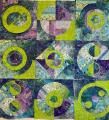FMQ - Queen size quilt?
#1
Super Member
Thread Starter
Join Date: Mar 2008
Location: Pacific NW
Posts: 4,393
Greetings!
In another thread quiltlady1941 commented on injuring herself while free motion quilting a queen size quilt. I didn't want to hijack her thread, and hope she heals quickly. It did, however, make me curious about how to do FRQing on that large a quilt on a domestic machine. I know one way would be to use a quilt-as-you-go method. Any other ideas? I have enough trouble managing to straight-line quilt something that large, so I don't know how I would manage to move it around for free motion.
Thanks for your comments.
In another thread quiltlady1941 commented on injuring herself while free motion quilting a queen size quilt. I didn't want to hijack her thread, and hope she heals quickly. It did, however, make me curious about how to do FRQing on that large a quilt on a domestic machine. I know one way would be to use a quilt-as-you-go method. Any other ideas? I have enough trouble managing to straight-line quilt something that large, so I don't know how I would manage to move it around for free motion.
Thanks for your comments.
#2
Senior Member
Join Date: Jun 2011
Location: Orlando, FL
Posts: 416
I have done it but I don't find it fun. I use the 'squish' method. You need space to the left and back of the machine to support the quilt. I am lucky to have my sewing machine recessed into a cabinet. It also helps to have the quilt supported to the left of your chair. I pull out the drawers in my cabinet and place a piece of laminated shelving on the open drawers to act as an additional table support. Other people will lower their ironing boards and place to theier left or purchase a small folding table.
I start in the middle of the quilt and stabilize the quilt by stitching in the ditch between blocks/sashings/borders - working my way from the middle to the right - column by column. Half of the quilt is in the throat/harp of the machine just 'squished' there. You need to concentrate on the approximatley 6 inches that surround the needle. Those 6 inches need to be kept flat. The rest of the quilt can be 'pooled', 'puddled', 'squished' any way you want. Once I have finished half the quilt I rotate and stabilize the rest.
Then I start with the FMQ. Again I start in the middle and work my way to the right. Most of the time I am not doing anything fancy - some version of stippling, vines, hearts, etc. Occassionally I have selected a pattern for blocks, printed the quilt pattern on thin tissue paper (golden threads). then I adhere to the quilt with temporary spray adhesive and stitch through the paper. Afterwards I tear it off. Or use lightweight wash away stabilizer and draw/print your pattern on it.
I start in the middle of the quilt and stabilize the quilt by stitching in the ditch between blocks/sashings/borders - working my way from the middle to the right - column by column. Half of the quilt is in the throat/harp of the machine just 'squished' there. You need to concentrate on the approximatley 6 inches that surround the needle. Those 6 inches need to be kept flat. The rest of the quilt can be 'pooled', 'puddled', 'squished' any way you want. Once I have finished half the quilt I rotate and stabilize the rest.
Then I start with the FMQ. Again I start in the middle and work my way to the right. Most of the time I am not doing anything fancy - some version of stippling, vines, hearts, etc. Occassionally I have selected a pattern for blocks, printed the quilt pattern on thin tissue paper (golden threads). then I adhere to the quilt with temporary spray adhesive and stitch through the paper. Afterwards I tear it off. Or use lightweight wash away stabilizer and draw/print your pattern on it.
#3
Senior Member
Join Date: Dec 2010
Location: Newnan, Georgia
Posts: 630
I have done some queens and kings on a domestic machine with a 7 in. harp. I start in the middle and do a width that I choose and go down to the edge, turn quilt, start win the middle where you started before and go down to edge again. Doing this always moving the quilt to the right. When that side is quilted, do the same on the other side.
#4
Good info above.
Another thing is to be sure to have your quilt basted REALLY well. I use 505 and it holds everything together through all the squishing and turning that I have to do to get all that material under my needle.
Another thing I learned is that, when you get near the boarders, be sure you have the fabric flat underneath and you aren't sewing your fabric edges together as you sew your borders. (BTDT) Really flatten everything outaround the edges before you begin.
I also use the puddle technique, starting in the middle and working outwards.
Good luck!
Watson
Another thing is to be sure to have your quilt basted REALLY well. I use 505 and it holds everything together through all the squishing and turning that I have to do to get all that material under my needle.
Another thing I learned is that, when you get near the boarders, be sure you have the fabric flat underneath and you aren't sewing your fabric edges together as you sew your borders. (BTDT) Really flatten everything outaround the edges before you begin.
I also use the puddle technique, starting in the middle and working outwards.
Good luck!
Watson
#5
Power Poster
Join Date: Mar 2009
Posts: 15,639
You only have to maneuver 1/2 of the quilt in the throat space. That can be squished and accordion-folded with your one hand underneath the fold. Wearing gloves really helps. I use Christina Cameli's glove alteration where I cut out the index finger and thumb so I have enough traction with the other fingers and palm but I can easily thread needles. Works like a charm. (Actually I use cheap garden gloves with the rubberized palm side. I let them air out to get the chemical smell out first.
#6
Super Member
Join Date: Aug 2009
Location: United States
Posts: 2,222
Greetings!
In another thread quiltlady1941 commented on injuring herself while free motion quilting a queen size quilt. I didn't want to hijack her thread, and hope she heals quickly. It did, however, make me curious about how to do FRQing on that large a quilt on a domestic machine. I know one way would be to use a quilt-as-you-go method. Any other ideas? I have enough trouble managing to straight-line quilt something that large, so I don't know how I would manage to move it around for free motion.
Thanks for your comments.
In another thread quiltlady1941 commented on injuring herself while free motion quilting a queen size quilt. I didn't want to hijack her thread, and hope she heals quickly. It did, however, make me curious about how to do FRQing on that large a quilt on a domestic machine. I know one way would be to use a quilt-as-you-go method. Any other ideas? I have enough trouble managing to straight-line quilt something that large, so I don't know how I would manage to move it around for free motion.
Thanks for your comments.
#7
DJ.. I have FMQ a few king and queen size on my Brother VQ2400 it has a 11 inch throat space, this helps a lot.. I have done large quilts on my small throat machine before I bought the Brother and it worked out ok, I just went slow and squished the quilt instead of rolling it..just take your time and go slow and if you get tired rest for a while..hope you find where you want to go with FMQ, it can be a lot of fun to do..
#9
How difficult it is depends on the throat space and also what batting you are using. I have done a very large king using warm and natural batting on a machine with a 9.5 inch throat. A bit hairy in the center of the quilt but fine once I was out from the center a little. Supporting the quilt and having an extended table is part of the secret. You want as large a flat surface at the base of the needle as possible. For support, I work in a corner of the room, so the quilt can't slip off the left or back of my desk/table. I use my lap to support in front if there is more than will fit on the front of the table. It does take a bit of muscle to work a large quilt through the machine, so frequent breaks are a good idea.
#10
YOU CAN DO THIS...
My 2¢ worth of opinion. LOL
I mark the top before sandwiching. That way it never gets on the batting, For larger quilts I do a herringbone thread basting so the quilt isn't so darn heavy. Then quilt only 1/4 at a time. Since it's already marked it's not a huge problem AND I sew all the same way.. top to bottom (on just the one quadrant), from the middle out. I learned this in a Sue Nickels Machine Quilting Essentials class. Crafty's Ann Peterson teaches much the same method
Sharon Schambers herringbone basting method. https://www.youtube.com/watch?v=bhwNylePFAA
I'm getting away from pinning due to the weight it adds, and seems to make the sandwich harder to move about.
and practice practice practice. I'm not great at this yet, but I'm doing so much better after the class.
My 2¢ worth of opinion. LOL
I mark the top before sandwiching. That way it never gets on the batting, For larger quilts I do a herringbone thread basting so the quilt isn't so darn heavy. Then quilt only 1/4 at a time. Since it's already marked it's not a huge problem AND I sew all the same way.. top to bottom (on just the one quadrant), from the middle out. I learned this in a Sue Nickels Machine Quilting Essentials class. Crafty's Ann Peterson teaches much the same method
Sharon Schambers herringbone basting method. https://www.youtube.com/watch?v=bhwNylePFAA
I'm getting away from pinning due to the weight it adds, and seems to make the sandwich harder to move about.
and practice practice practice. I'm not great at this yet, but I'm doing so much better after the class.
Thread
Thread Starter
Forum
Replies
Last Post
NikiWalker
Main
9
08-15-2014 06:09 AM







